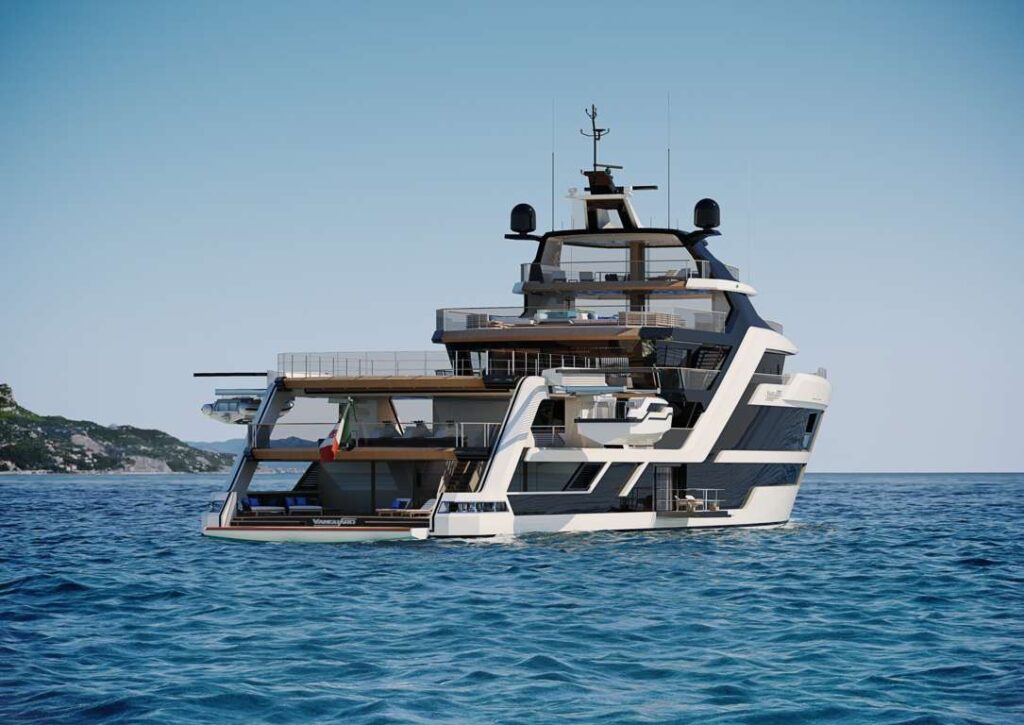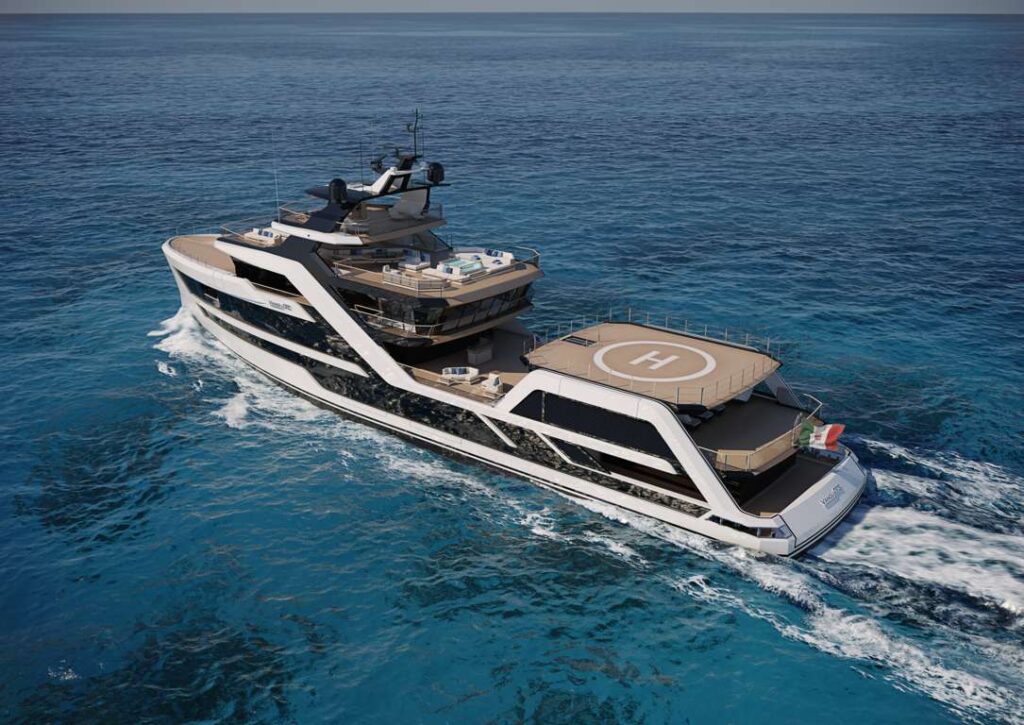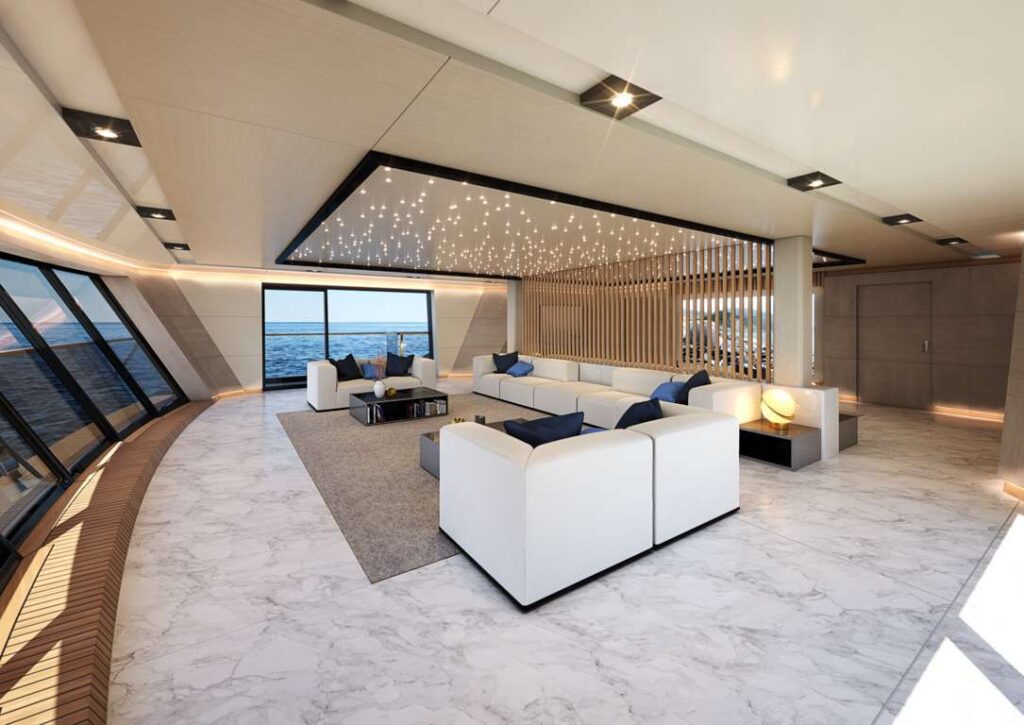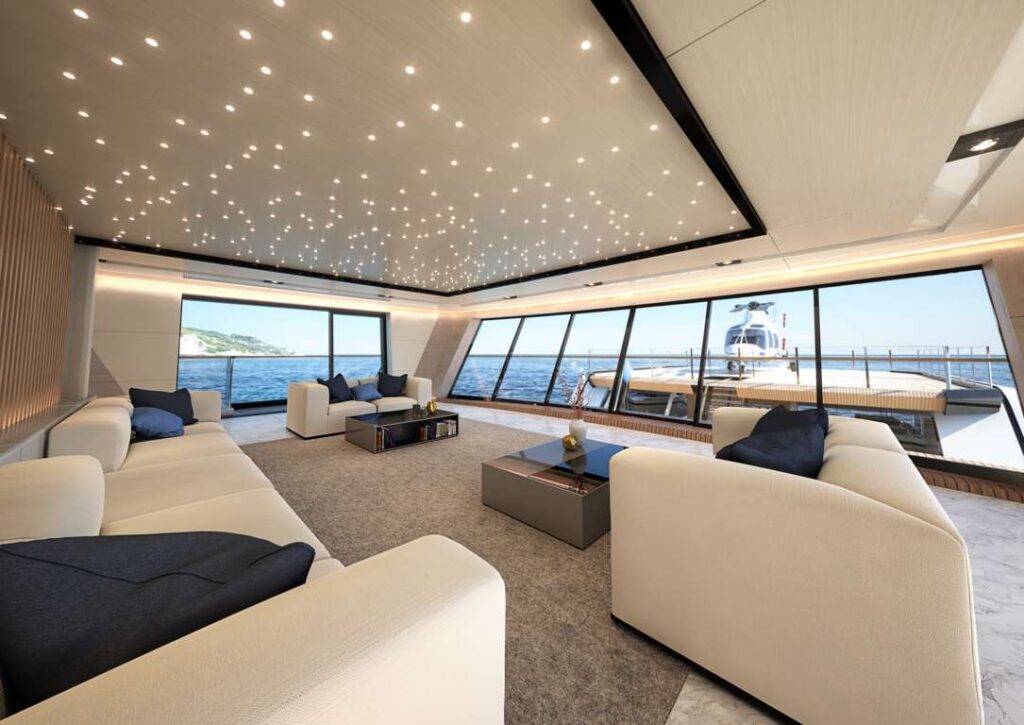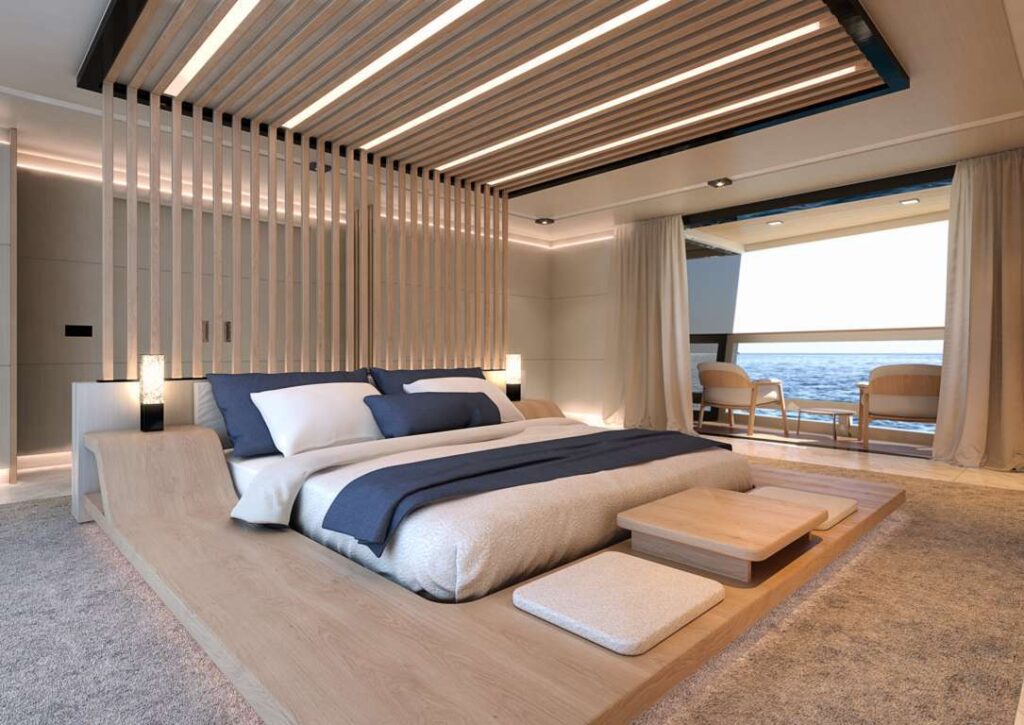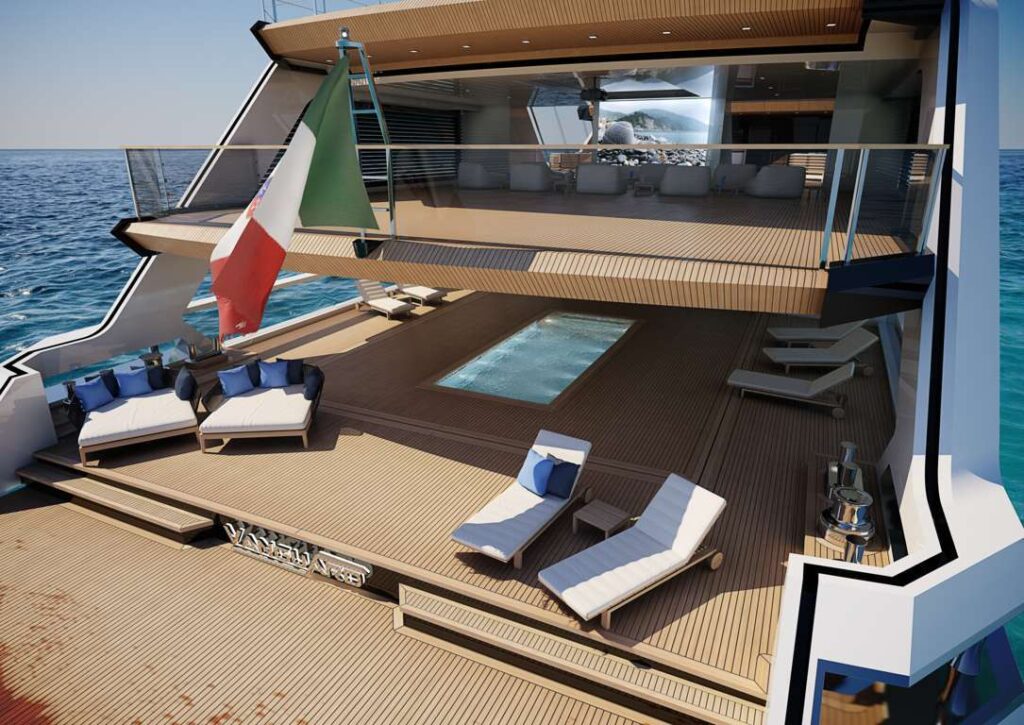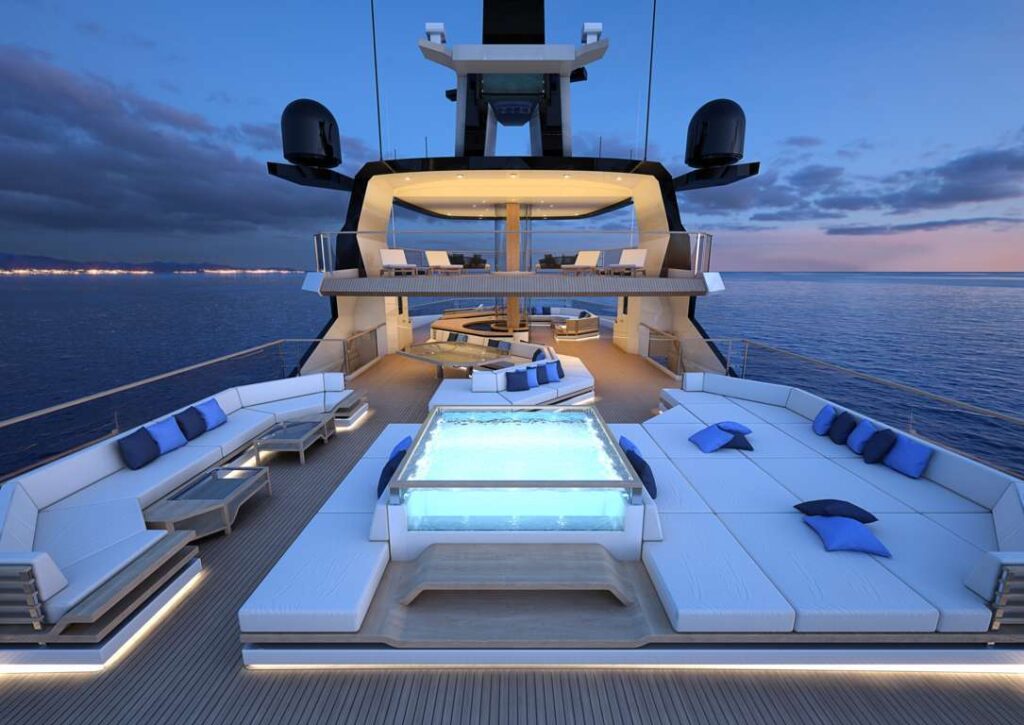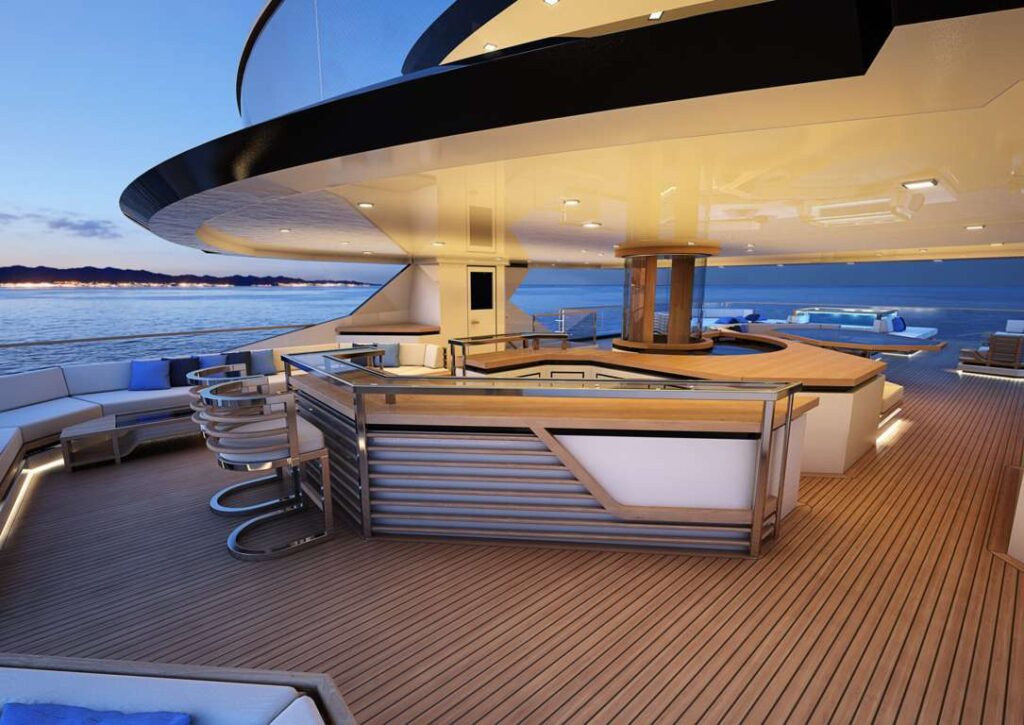On the 25th anniversary of ITS foundation, Hydro Tec REVEALS a 65-metre displacement explorer yacht to mark this important milestone. VANGUARD fully represents the spirit of the studio, Always pushing the boundaries of innovation and design, with pioneering spirit, firmly anchored to a solid technical base.
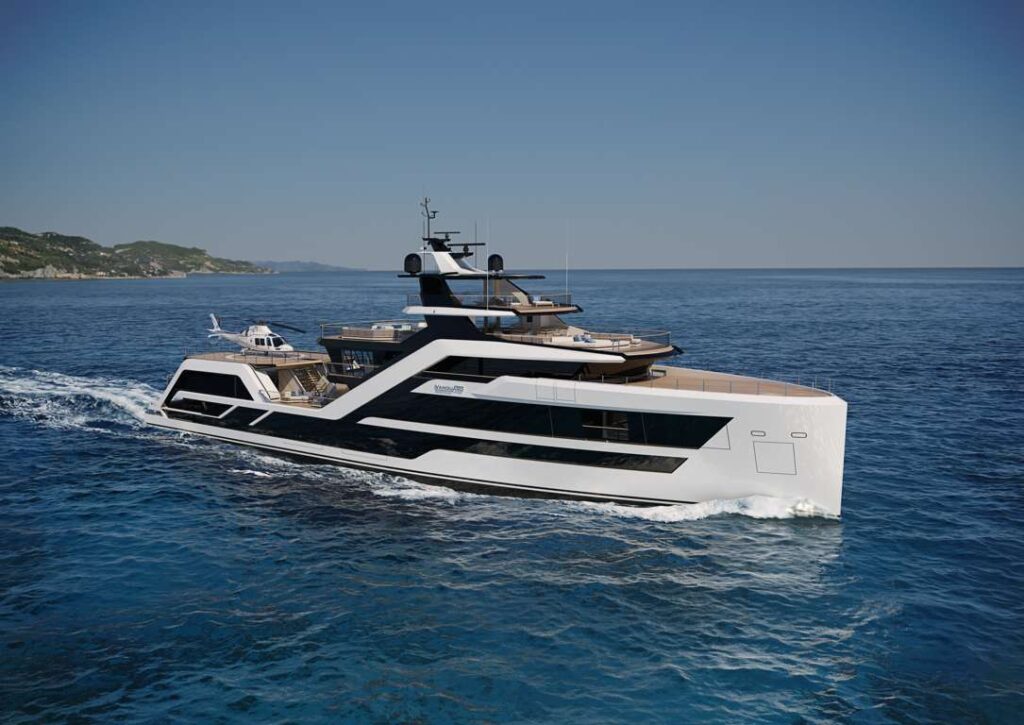
The project Hydro Tech presented to celebrate Sergio Cutolo’s studio 25th year of activity, fits perfectly with the idea underlying this special edition that will close the year 2020: to feature in about 200 pages the leading figures of the yacht design sector.
The rapid technological development that the last 20 years have witnessed, has muted almost every habit of hours, causing us, on the one hand, to live in a much more fast-paced world and providing new visions and solutions on the other. Protagonists of the first 20 years of the new millennium have been IPhones, IPads, AppleWatches, the 5G, social media, the sharing community (Uber and so on), electric cars, self-driving cars, virtual assistants, cloud computing, drones, augmented reality, the gaming blending together real and virtual reality, dating, Google’s quantum supremacy and lastly, the space race with the SpaceX project.
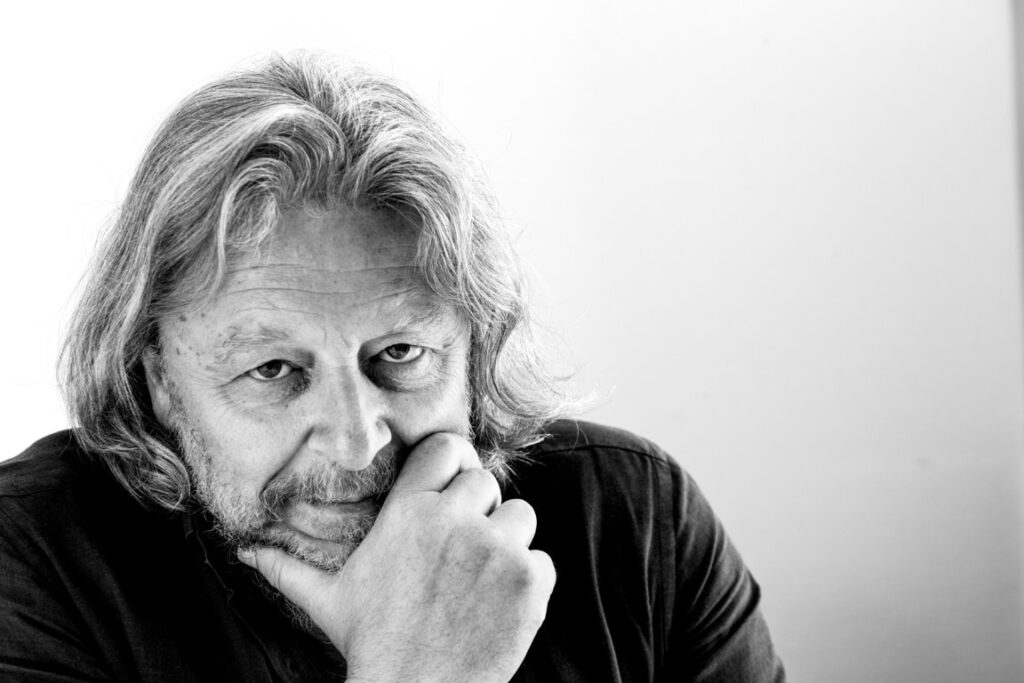
“The Explorer concept has evolved considerably in the last ten years. this led me to take a step forward, developing one unique project where we could concentrate all our experience gained in 25 years of design activity”, SERGIO CUTOLO.
In this fervid technological-economic-social context, that was even faced with no less that a global pandemic, the nautical, architectural and design sectors must not be forgotten. Despite the period of crisis from 2008 to 2013, they did not hold back on evolution, and were able to present ever innovative solutions that perfectly line up with the new class of owners that has emerged.
The Vanguard project by Hydro Tec does not only testifies the 25 years of experience gathered so far, as the studio remarks, but is at the same time an implicit expression of the big changes that have characterized the new millennium.
The name Hydro Tech chose for this project, Vanguard, is very evocative and representative of the maturity of the studio. As the studio explains, this name is inspired by the British marine tradition, which in fact since 1580 has always had in its fleet a British warship carrying the name Vanguard. In its original meaning, the “avant-garde” is referred to those who lead the way and therefore, figuratively speaking, are ahead of their time. So, as we already reported, this project results from past experience, but shows at the same time a hint of the future direction. Let’s now take a closer look at it.
A castle in the middle of the sea – A castle in the middle of the sea… a rock, the magic of the inaccessible Mont Saint Michel with its high walls but, at the same time, open to the view and to the horizon thanks to its windows and terraces, this is the inspiring idea behind Vanguard.
This 65-metre explorer has been designed on a displacement platform, which develops a considerable width and which alters the vertical position of the various decks, creating a bridge “below deck” well above the full load waterline.
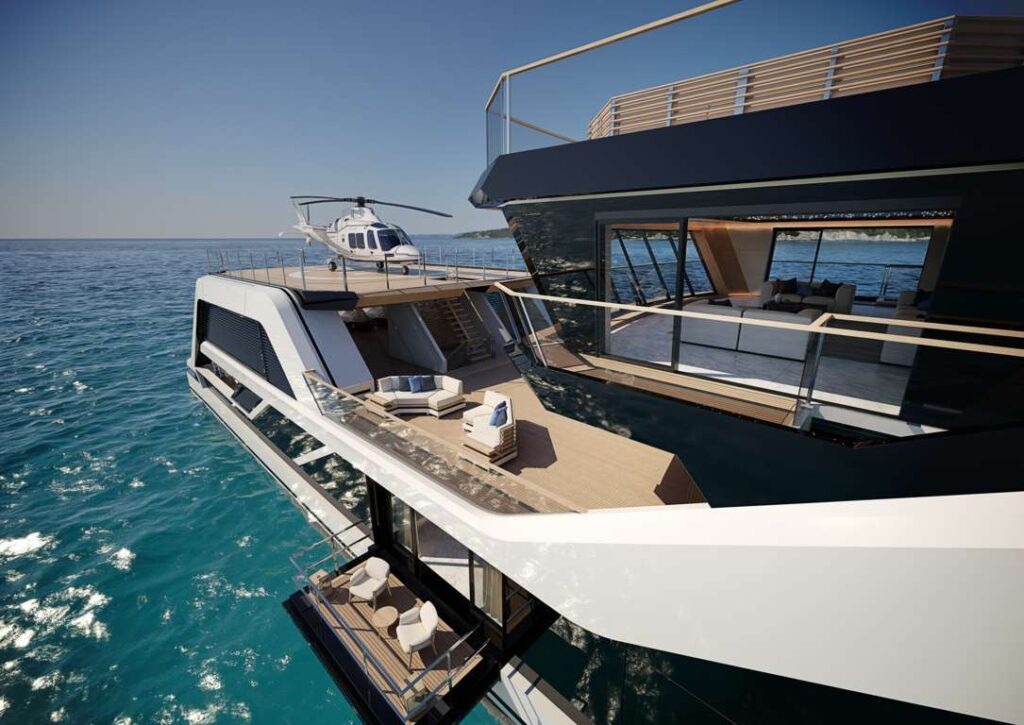
This kind of design allows to include mobile terraces at the level of the guest cabins and well above the waterline; at the same time the under-lower deck benefits from larger spaces that can be used as technical areas and hold. Here we also find a large engine room which occupies a minimum space on the lower deck, essentially intended for air intakes only.
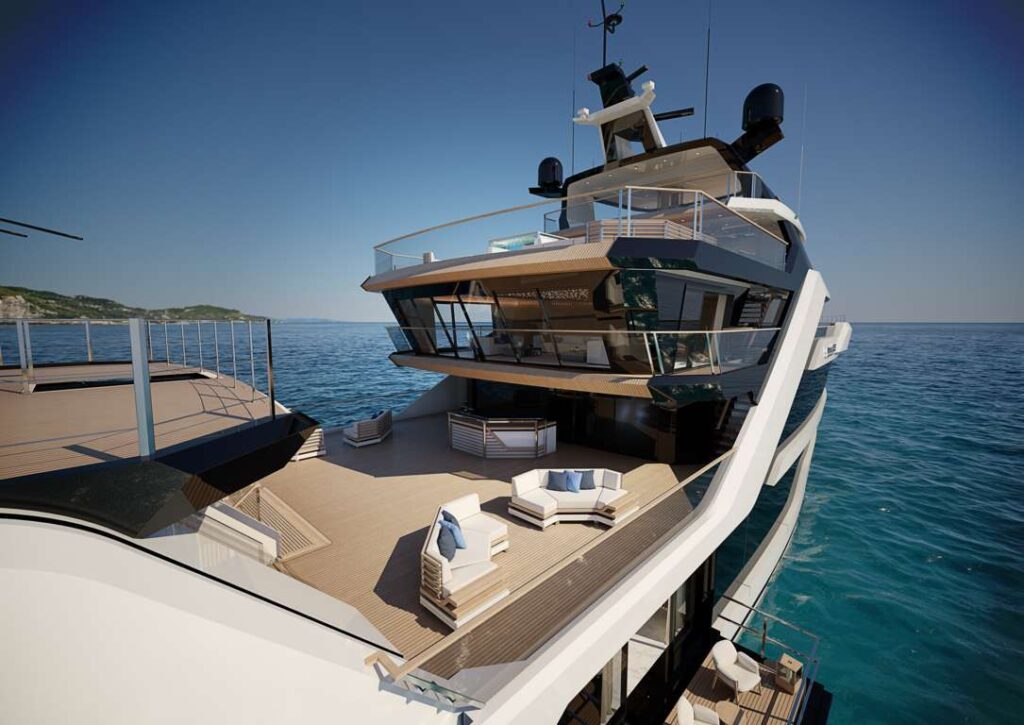
With this layout, the lower deck becomes a fully usable deck, from the bathing platform to the collision bulkhead, which allows guests an easy and direct access to the beach area and the spa. A large heated swimming pool occupies the central area of the beach area which is completely covered and opens towards the stern thanks to a foldable side. In this way, the pool can also be used when the climate is too hot or too cold and the part of the folding side becomes an extension of the beach area itself. The forward area of the lower deck is occupied by the crew cabins and galley.
Going up to the main deck, we find towards the stern, a covered area for tenders and toys, which thanks to bridge cranes and side doors can be easily launched, letting the space available and usable for outdoor activities.
Moving forward you can find an open lounge and the main saloon, with adjoining dining room and TV/Entertainment area. Further on, at bow, we find the galley and the pantry on the left and access to the owner’s suite on the starboard side. The owner’s suite includes a large office, a relaxation area, a dressing area and two terraces on both sides.
On the upper deck we find at aft the technical area, which consists of the bridge, the captain’s office and cabin. This deck is designed with a large panoramic sky lounge, with an adjoining cinema area and outdoor terrace. This deck is also equipped at stern with the helipad.
The two upper levels are occupied by two large open lounges served by a lift and a dumb waiter. From a technical point of view, Vanguard’s propulsion is entrusted to two MTU main engines connected to two fixed blade propellers via shaft lines as well as two electric motors powered by the on-board network. These electric motors allow her to travel at speeds of up to about 10 knots in electric diesel mode.
Article published in Superyacht Digest | Winter Issue 2021
Q&A with SERGIO CUTOLO
SD: “25 years and still going strong. Sergio Cutolo and his Hydro Tec have not set aside their desire for new discoveries. What are the fields – the aspects – that are yet to be uncovered within the sphere of naval architecture?”
SC: “My passion for hydrodynamics or, better said, for fluid dynamics in general, stems from my fascination for sailing boats, which I never got to manifest from a design point of view, but that kickstarted in me an “innate” sensitivity towards this discipline. My studies in Naval Engineering provided me with the basic knowledge, that was later complemented by the experience as a designer throughout the years. Initially at Baglietto, and at Rodriquez later, I concentrated on fast hulls, while over the last years, dislocating hulls have been my focus. At present, I would like to delve deeper into the idea of motorized catamarans, which I have already explored for fast passenger transport contexts, but never applied to a megayachts. Perhaps the new concept by Hydro Tec will be a catamaran. For this kind of vessels, one must think out of the box, it all starts from a blank sheet”.
SD: “What are the main gratifications that this sector has given to you?”
SC: “Many gratifications, much effort. The most rewarding moments of a project take place at the beginning, the more creative phase, and at the end, when you find yourself sailing on a boat that you have first imagined, sketched and finally designed. And let’s not forget about the meetings: clients, colleagues, communicators; the nautical world in general, and that of megeyachts in particular, gives you the privilege to come into contact with very surprising personalities”.
SD: “After 25 years, is there anything you would like to take off your chest? In other words, has anyone ever disappointed you in the nautical world?”
SC: “If I started to “take things off my chest”, a crowd of old men watching the shipyard would gather…jokes aside, as I mentioned before, the nautical world offers the chance to meet extraordinary people. The most important entrepreneurs have, or have had, a yacht; I think about the ones who no longer accompany us, from Onassis to Steve Jobs, I think of Paul Allen, Bezos, Larry Ellison, our Del Vecchio, Armani, Gabbana, the late Andrea Merloni. All innovators in their fields, as well as in their ways of conceiving and using a yacht. Nevertheless, this golden world has too often caught the attention of adventurers, only attracted by the mirage of easy gains and the perspective of prestigious acquaintances, that little have to do with the complexity of the product. These people have caused a grate damage to a sector that is based on hard work and on the ability to always come up with new ideas. No wonder us Italians are at the top”.
SD: “Talking now about Vanguard, the attention to details is undeniable. Not only in terms of how the spaces are conceived, hence the idea of freeing the Lower Deck and exploit every inch of it, but also in the conception of a much freer lifestyle on board, less ordinary and more natural. The design seems inspired by the idea of a complete and embracing wellbeing across all decks. After air-water-land-light, wellbeing could be the quintessence of the nautical experience. Do you agree with this interpretation?”
SC: “Vanguard indeed is a floating SPA. Since the earliest stages, the idea behind the project was that of a flexible layout and ideal movement. On board of yachts, especially bigger ones, often there are fixed paths and duplicated areas. In this case, we tried to bend the regulatory requests to the architectural needs in order to create continuity and differentiate the spaces according to their function and position aboard. This is the distinctiveness of our studio, having the chance to analyse every project in its entireness, without overlooking any aspect. The continuity you were pointing out, can be seen on the Lower Deck, which enables guests to enter the Beach Club directly from their cabins, without having to cross the Main Deck or the other exterior decks.
The swimming pool area can be closed off thanks to the sliding doors; this provides the opportunity to use the pool in cold as well as warm weather. The tender area, located on the main deck, is another “flexible” space; once launched, it can be turned into a covered terrace, just like the heli-deck.
The sun deck features vast and articulated spaces, great for enjoying outdoor navigation with all the comforts; it is covered by a big hardtop which offers yet again a space suitable for discoveries and observation. Even the halls are versatile, being designed for social meetings and observation. The main deck hall also houses a panoramic, formal dining area and a lounge corner, in perfect symmetry, turned towards the large windows. On the other hand, the upper deck hall offers a 180-degree view and a TV/Entertainment area at bow. The owner’s suit has ample and articulated spaces, with two lateral terraces that make up a private outdoor area only accessible to the owner.
SD: “How does this project compete in the Explorer segment? To what kind of owner is it addressed?”
SC: “From where I stand, one of the traits that every Explorer should have, is the ability to cruise for a long time without having to return to the port to refuel or restock the galley. Such characteristic is not always to be found in traditional yachts under 500 GT. Over 500 GT, it is safe to say that every yacht is able to sail for longer periods without stops, and to face the ocean in tranquillity. There are other features: for example, the possibility to board many tenders and toys is fundamental. Many large yachts rent toys when they reach their destination: moving in poorly equipped areas, a real Explorer should provide and entertain its guests with adequate tenders and a vast array of toys and equipment (for diving, to quote one). Flexibility in the usage of spaces is another characteristic proper of Explores: the option of having a helipad, of using the tender areas when the tenders themselves are in the water, of exploiting the full potential of outdoor spaces, access to the sea and so on”.
SD: “Clients ask for a higher level of safety in Explorer yachts. How does Vanguard keep up with such requirements?”
SC: “True Explorer Yachts use an oversized naval platform when you compare to similar length or similar tonnage conventional yachts. The maximum beam is usually higher, and this gives higher stability and allows for higher freeboard, which, again, is an important factor in terms of safety. The Hybrid Propulsion System offers full redundancy: the two electric motors can provide emergency propulsion using the main generators as power source, but can also provide full electric power under way when using main engines”.
SD: “The relation between Vanguard and Mont-Saint Michel is a clear poetic image. How can you explain it from an architectural standpoint?”
SC: “A few years ago I spent a couple of weeks in Bretagne, one of my favourite places. On that occasion I paid a visit to Mont-Saint Michel. Unlike most tourists, I decided to spend two nights on the cliff. It was an unforgettable experience, thanks to the atmosphere that surrounds the place at night and at dawn, when there aren’t visitors. The evening silence, the awakening to the sound of bells and cries of seagulls. The parallelism with Vanguard, though, comes from the architectural/urbanistic conformation of the cliff.
Vanguard’s hull is tall and vertical, almost inaccessible to the water, and so is the cliff; moving upwards we find large windows and open spaces, just like the bastions of a castle. On top of the cliff is the cathedral: the impervious and impregnable walls give way to fragile and large, gothic glass-windows. Here the gaze lingers over the landscape and the breath-taking sunsets that draw the mountain shadow on the tide that begins to surround it. This is the contrast: unreachable, protective and arduous at the base, but open towards the outside world at the top, with its steeple towering over the big windows”.
SD: “Flexibility is a key element of creating an explorer vessel, which is so much more performance-based than conventional superyachts: it needs to be very adaptive to different environments, adventures and demands. The more successful explorer designs are the ones which perform to clients’ wishes, whilst retaining the luxurious aspects of a conventional yacht. What about Vanguard’s flexibility and performance?”
SC: “I was already mentioning the flexibility of the various areas of the Yacht, in terms of their destination and use. These Yacht are going to be used in different areas of the world and different seasons. The beach area is a god example concerning your point: the big pool can be totally enclosed by sliding glass panels and the full area can be controlled as regards climate. This will allow to use the beach area both in very hot and very cold climate”.



